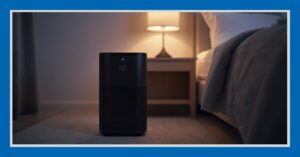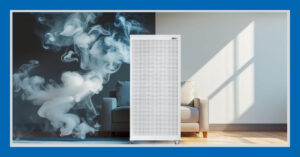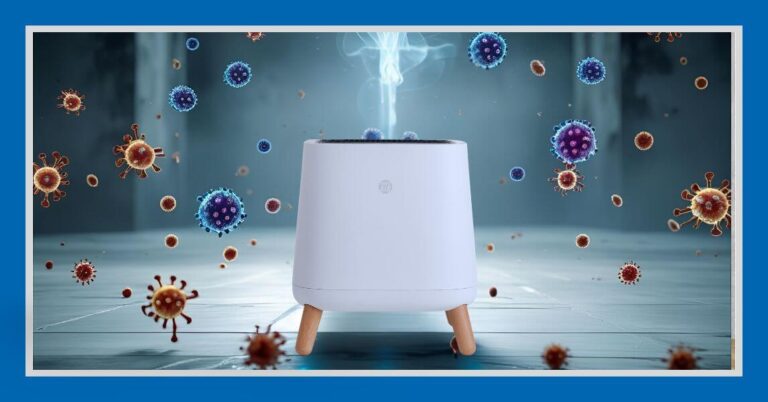
Air Purifiers for Viruses & Bacteria: Your Complete Guide
by Peemanus Tongpiem / July 9, 2025
In an era where PM2.5 dust, viruses, and bacteria have become invisible threats, having an air purifier that disinfects at home is no longer a luxury. This is especially true for models using HEPA filter technology, which is the core component for efficiently filtering micron-sized particles, including dust, bacteria, and viruses in the air. This article will guide you on how to choose air purifiers for viruses and bacteria effectively, recommend popular models, and provide tips for maximizing their use. For more insights on how to choose an air purifier that’s right for you, visit our blog.
Why Use a HEPA Air Purifier for Disinfection?
HEPA (High-Efficiency Particulate Air) is a high-quality filter that can capture particles as small as 0.3 microns with an efficiency of up to 99.97%. This means it can filter out various airborne contaminants such as fine PM2.5 dust, pollen, mold spores, and even certain types of viruses and bacteria comprehensively. If you’re wondering what a HEPA filter is in more detail, we have a dedicated guide.
While HEPA cannot directly kill viruses or bacteria like UV light, its ability to filter them out of the air before we breathe them in significantly helps reduce the risk of respiratory diseases, allergies, and airborne viruses. This capability is particularly vital when considering a best HEPA air purifier for COVID protection, as these filters can effectively capture virus-laden aerosols, helping to reduce airborne transmission risks. To understand the broader context of how air purifiers work, check out our detailed article.
Key Features of HEPA Air Purifiers for Disinfection
- Effectively Filters Viruses and Bacteria in the Air: HEPA filters of H13 or H14 grade are certified to filter particles between 0.1 – 0.3 microns, which is within the size range of coronaviruses (COVID-19) and bacteria, very effectively.
- Safe, No Ozone Emission: Unlike some air purifiers that use Ionizers or Plasma which may release ozone, HEPA technology does not produce harmful chemicals or gases, making it safe for children, the elderly, and pets. If you’re concerned about why your air purifier might smell bad or about harmful emissions, ensure your unit is ozone-free
- Easy Maintenance: Filters can be replaced by yourself. The average lifespan is 6-12 months, depending on the brand and usage. This contributes to the overall benefits of air purifiers by keeping them efficient.
Important Components of HEPA Air Purifiers for Disinfection
- Choose HEPA H13 or H14 Filters: Don’t be misled by terms like “HEPA-like” or “HEPA-grade,” as they may not meet true efficiency standards. Always verify filter specifications to ensure you’re getting the best protection. Our guide on what is a HEPA filter provides more clarity.
- Calculate Room Size and CADR Value: The Clean Air Delivery Rate (CADR) should correspond to the room size. For example, a 20 sq.m. room should have a CADR of at least 200 m³/hr. Learn more about what is a CADR rating and how to choose the right one for your space to ensure effective air purification.
- Operating Noise Level: If for use in a bedroom, choose a model with noise not exceeding 30 decibels in silent mode to avoid disturbing sleep. This is a key factor when you’re looking for how to choose an air purifier for comfort.
- Filter Replacement Frequency: Check how often filters need changing and if there’s an automatic reminder light, as well as the future cost of filters. This affects the overall running cost and is a good question to ask when wondering why air purifiers are so expensive.
How to Choose a HEPA Air Purifier for Disinfection to Suit Your Home
- Choose HEPA H13 or H14 Filters: Don’t be misled by terms like “HEPA-like” or “HEPA-grade,” as they may not meet true efficiency standards. Always verify filter specifications.
- Calculate Room Size and CADR Value: The Clean Air Delivery Rate (CADR) should correspond to the room size. For example, a 20 sq.m. room should have a CADR of at least 200 m³/hr. Learn more about choosing the right CADR for your space.
- Operating Noise Level: If for use in a bedroom, choose a model with noise not exceeding 30 decibels in silent mode to avoid disturbing sleep. Understanding air purifier noise levels can help you make an informed decision.
- Filter Replacement Frequency: Check how often filters need changing and if there’s an automatic reminder light, as well as the future cost of filters.
Recommended HEPA Air Purifiers for Disinfection
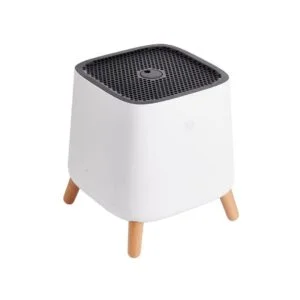
1. Sqair – HEPA Air Purifier: Simple Design for Every Home
Details:
- Filters with HEPA H13, eliminating over 99.95% of airborne bacteria and viruses. (For a deeper dive into how air purifiers work, visit our detailed guide.)
- Covers an area of up to 40 sq.m., ideal for bedrooms or living rooms. (Learn more about what is a CADR rating to ensure optimal coverage.)
- Minimalist design, easy to use with a single rotary knob.
- No ozone emission system, safe for everyone in the home. (Understand why this is crucial by reading about why your air purifier might smell bad if it produces ozone.)
Suitable for:
- Those seeking an air purifier for disinfection that is easy to use, beautifully designed, and fits any home style. (See why Sqair is often listed among the best air purifiers in Thailand.)
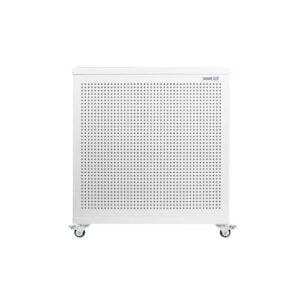
2. Blast Mini – Small Disinfecting Air Purifier for Targeted Areas
Details:
- Uses a HEPA H13 filter.
- High CADR of up to 740 (CFM 435).
- Filters PM2.5 dust and disinfects in areas up to 100 sq.m. (Explore our guide on Best Large Room Air Purifiers in Thailand 2025 for more high-performance options.)
- Low noise, suitable for use in bedrooms or children’s rooms.
- Compact size, easy to move.
Suitable for:
- People with limited space, or those who want a powerful yet compact unit for specific areas, such as next to the bed or on a desk.
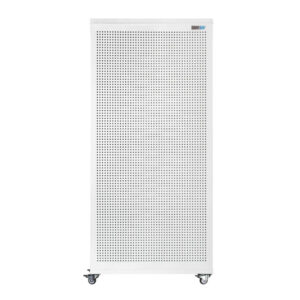
3. Blast – Large Air Purifier: Hospital-Grade Disinfection
Details:
- Uses a HEPA H13 filter, same grade as used in hospitals.
- High CADR of up to 950 (CFM 560), rapidly filtering pathogens in large areas. (Discover how long it takes for an air purifier to clean a room with high CADR units.)
- Covers an area of up to 150 sq.m., ideal for offices, clinics, or large homes. (This model is frequently featured in lists of Best Large Room Air Purifiers in Thailand 2025.)
- Robust construction with wheels, easy to move.
Suitable for:
- Those who need a powerful air purifier for disinfection, covering a wide area, for use in offices or large homes. It’s a top choice for environments prioritizing significant benefits of air purifiers for health and air quality.
Comparison of 3 HEPA Air Purifiers for Disinfection
| Air Purifier Model | Coverage Area | HEPA Filter | CADR (m³/hr) | Noise Level | HEPA Lifespan | Key Features |
| Sqair | Up to 40 sq.m. | HEPA H12 (99.5%) | 315 | 23–52 dB | ~6 months | Minimalist design, lightest in its class. Disinfects PM2.5, viruses, bacteria. |
| Blast Mini | 60–100 sq.m. | HEPA H13 (99.95%) | 740 | 35–49 dB | 12–17 months | High power, not like a hotel. Quieter than IQ Air by 20 dB. |
| Blast | Up to 150 sq.m. | HEPA H13 (99.95%) | 950 | 29–43 dB | 17–22 months | Clinic-grade large unit, good value, with wheels. |
Export to Sheets
How to Use a HEPA Air Purifier for Maximum Results
To maximize the effectiveness of your HEPA air purifier, especially as a vital component for home air quality and as a potentially best HEPA air purifier for COVID protection, consider these practices:
- Run 24/7: For continuous clean air, keep your air purifier running at all times, especially in areas with high occupancy or during peak pollution/virus seasons.
- Proper Placement: Place the unit in an open area, away from walls or furniture that might obstruct airflow. The center of the room is often ideal for optimal air circulation. For more tips on air purifier placement, refer to our guide.
- Match CADR to Room Size: Ensure the purifier’s CADR is appropriate for your room’s dimensions for optimal air changes per hour.
- Regular Filter Replacement: Adhere to the manufacturer’s recommended schedule for changing filters. A clogged filter loses efficiency, reducing its ability to capture harmful particles.
- Maintain Cleanliness: Regularly wipe down the exterior of the unit and clean pre-filters if they are washable.
- Address Sources: While an air purifier helps, reducing indoor pollutants (e.g., proper ventilation, avoiding indoor smoking) further enhances air quality. Learn more about improving overall indoor air quality.
Do Personal Air Purifiers Work Against COVID?
While the main focus is on whole-room HEPA purifiers, it’s important to address the efficacy of personal air purifiers. Generally, personal air purifiers have limited effectiveness against airborne viruses like COVID-19 for overall room protection. They primarily create a small zone of cleaner air directly around the user. For comprehensive protection in a shared space, a larger, whole-room HEPA air purifier is significantly more effective as it filters the air for everyone in the room. If you’re considering different types of air purifiers and their uses, you can find more information on our blog.
Bottom Line
PM 2.5 dust, viruses, and bacteria are ever-present concerns. Understanding their causes and the crucial role of HEPA air purifiers in mitigating them is vital. By choosing the right HEPA air purifier, maintaining it correctly, and understanding its capabilities against airborne threats like COVID-19, you can significantly enhance the air quality and safety of your home.

Peemanus Tongpiem
เราให้ความสำคัญกับอาหารที่เรารับประทาน 3 มื้อต่อวัน แต่เรากลับละเลยอากาศที่เราใช้หายใจมากกว่า 10 ครั้งต่อนาที เป็นเหตุให้ผมเริ่มค้นคว้าและเผยแพร่ความรู้เรื่องมลพิษทางอากาศ เพื่อให้ผู้คนตระถึงความสำคัญของการใช้เครื่องฟอกอากาศเพื่อสุขภาพที่ดีขึ้น

